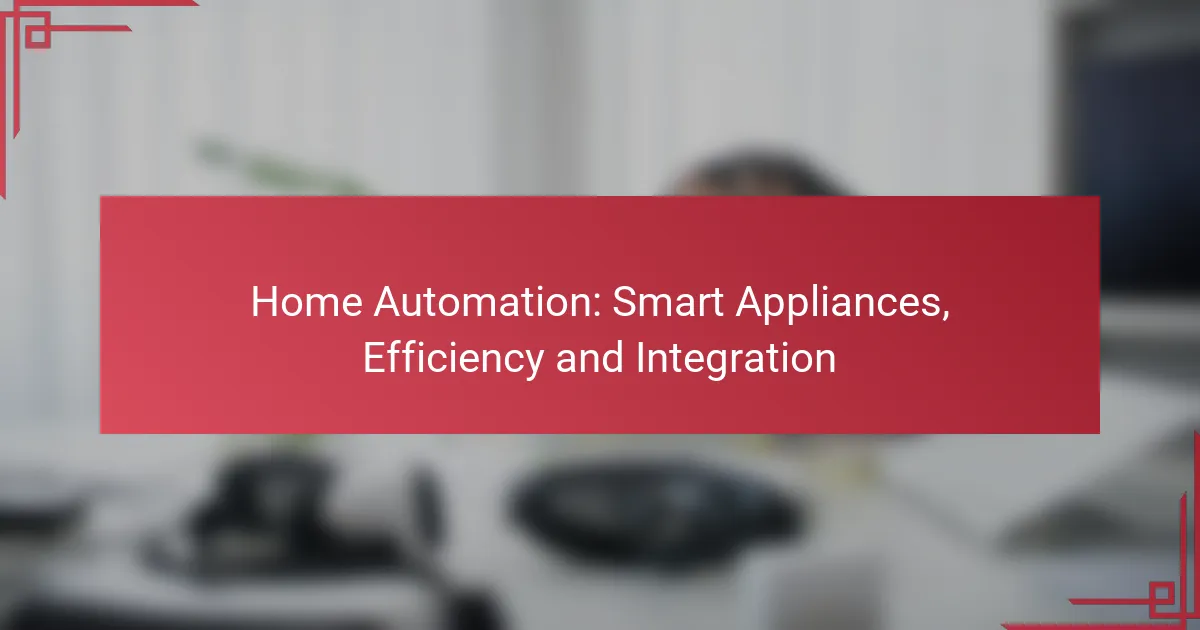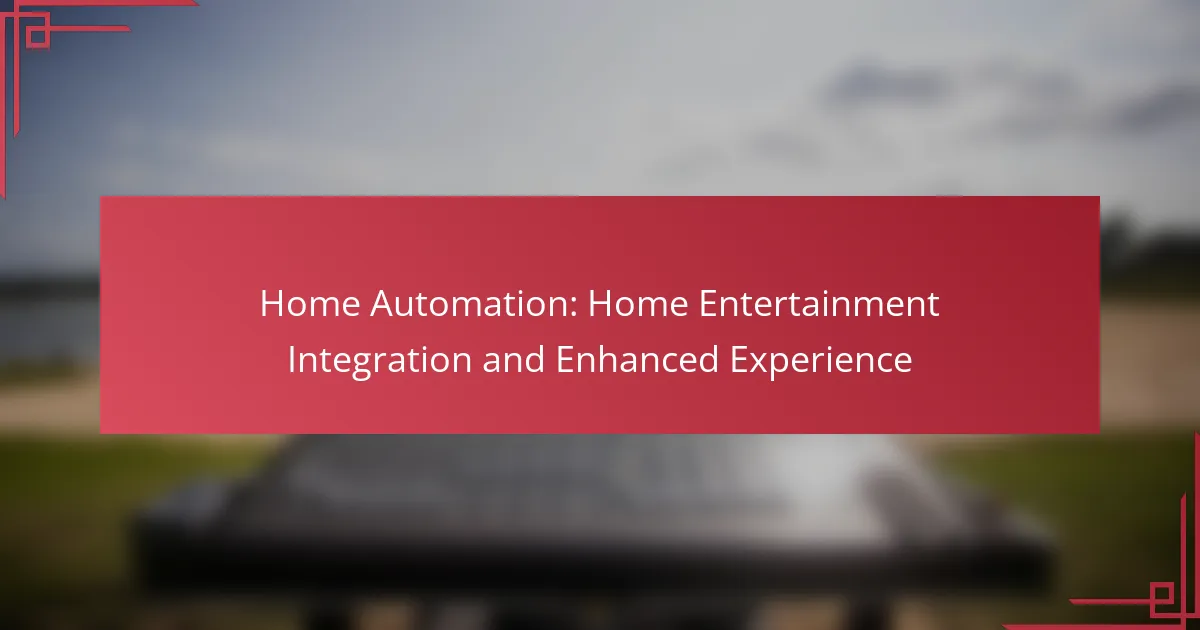Home automation through smart appliances is revolutionizing the way we manage our households, particularly in terms of efficiency and convenience. By optimizing energy use and automating daily tasks, these devices not only lower utility bills but also enhance control over various household functions. Integrating smart appliances into your home allows for seamless connectivity and centralized management, making everyday living more efficient and enjoyable.
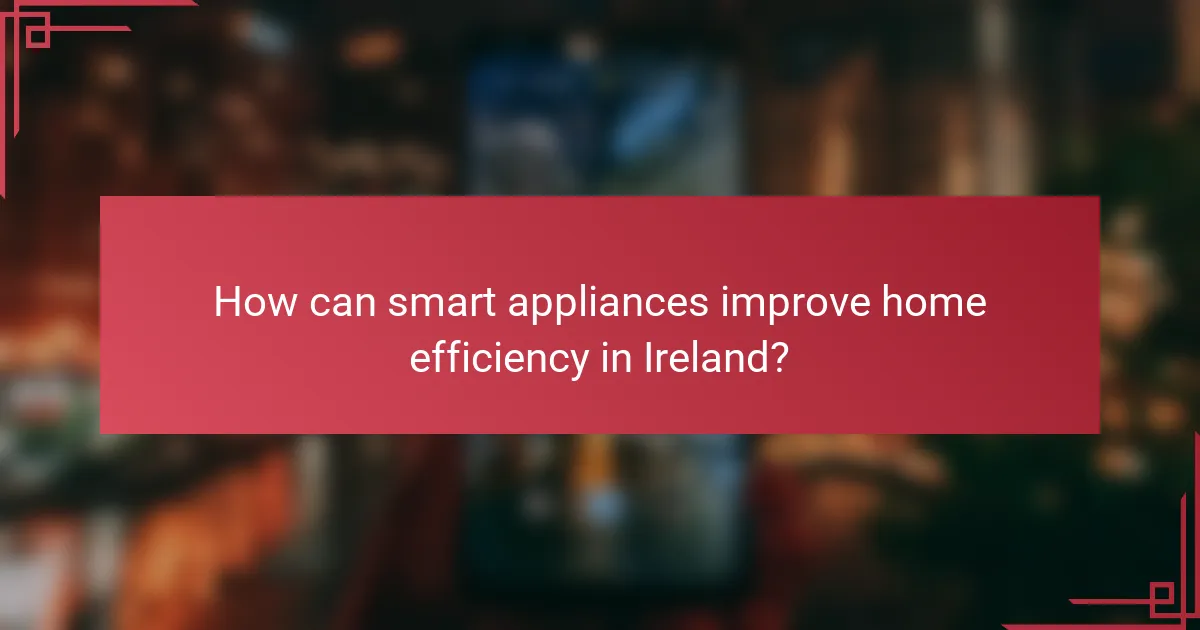
How can smart appliances improve home efficiency in Ireland?
Smart appliances can significantly enhance home efficiency in Ireland by optimizing energy use and automating daily tasks. These devices leverage technology to reduce waste, lower utility bills, and provide greater control over household functions.
Energy-saving features
Many smart appliances come equipped with energy-saving features that help reduce electricity consumption. For instance, smart refrigerators can adjust their cooling levels based on usage patterns, while smart washing machines optimize water and energy use based on load size. These features can lead to savings of around 10-30% on energy bills.
In Ireland, where energy costs can be high, utilizing appliances with energy-efficient ratings, such as A+++ or A++, can further enhance savings. Look for appliances that comply with EU energy labeling regulations to ensure you’re making an informed choice.
Automated scheduling
Automated scheduling allows users to set specific times for appliances to operate, taking advantage of lower energy rates during off-peak hours. For example, a smart dishwasher can be programmed to run at night when electricity costs are typically lower. This not only saves money but also helps balance energy demand on the grid.
To maximize efficiency, consider using a home automation system that integrates with your appliances, allowing for seamless scheduling and management. This can lead to more efficient energy use and reduced environmental impact.
Remote monitoring
Remote monitoring enables homeowners to track and control their appliances from anywhere using a smartphone or tablet. This feature allows users to check energy usage in real-time, receive alerts for maintenance needs, and even turn appliances on or off remotely. For instance, you can monitor your heating system and adjust it while away from home to ensure optimal energy use.
Incorporating remote monitoring can help identify patterns in energy consumption, allowing for better decision-making regarding usage habits. This can lead to further reductions in energy costs and improvements in overall home efficiency.

What are the best smart appliances for home automation?
The best smart appliances for home automation enhance convenience, efficiency, and control in daily tasks. Key options include voice-controlled devices, smart lighting systems, and intelligent refrigerators that help manage inventory and reduce waste.
Amazon Echo for voice control
The Amazon Echo serves as a central hub for voice control in a smart home. It allows users to operate various compatible devices through simple voice commands, making it easy to adjust settings without manual effort.
When integrating the Echo, ensure compatibility with your existing smart appliances. Popular brands like Philips Hue and smart thermostats often work seamlessly with Echo, enabling a cohesive smart home experience.
Consider placing Echo devices in high-traffic areas for optimal voice recognition. Avoid locations with excessive background noise to enhance performance.
Philips Hue for smart lighting
Philips Hue offers a versatile smart lighting solution that can be controlled remotely or through voice commands. Users can adjust brightness, color, and schedules, creating personalized lighting scenes for different occasions.
To set up Philips Hue, start with a Hue Bridge, which connects to your Wi-Fi network. From there, you can add bulbs and control them via the Hue app or compatible voice assistants like Amazon Alexa.
Be mindful of the initial investment in smart bulbs and the Hue Bridge, but the energy savings and convenience can justify the cost over time. Consider using dimmable bulbs to further enhance energy efficiency.
Samsung Smart Fridge for inventory management
The Samsung Smart Fridge features advanced inventory management capabilities, allowing users to track food items and expiration dates. This appliance can send notifications when items are running low or nearing spoilage, helping to reduce food waste.
To maximize the benefits of the smart fridge, connect it to your home Wi-Fi and use the accompanying app to manage your grocery list. Some models even allow you to view the contents of your fridge remotely through internal cameras.
While the initial cost of a smart fridge can be higher than traditional models, the potential savings from reduced food waste and improved meal planning can make it a worthwhile investment for many households.
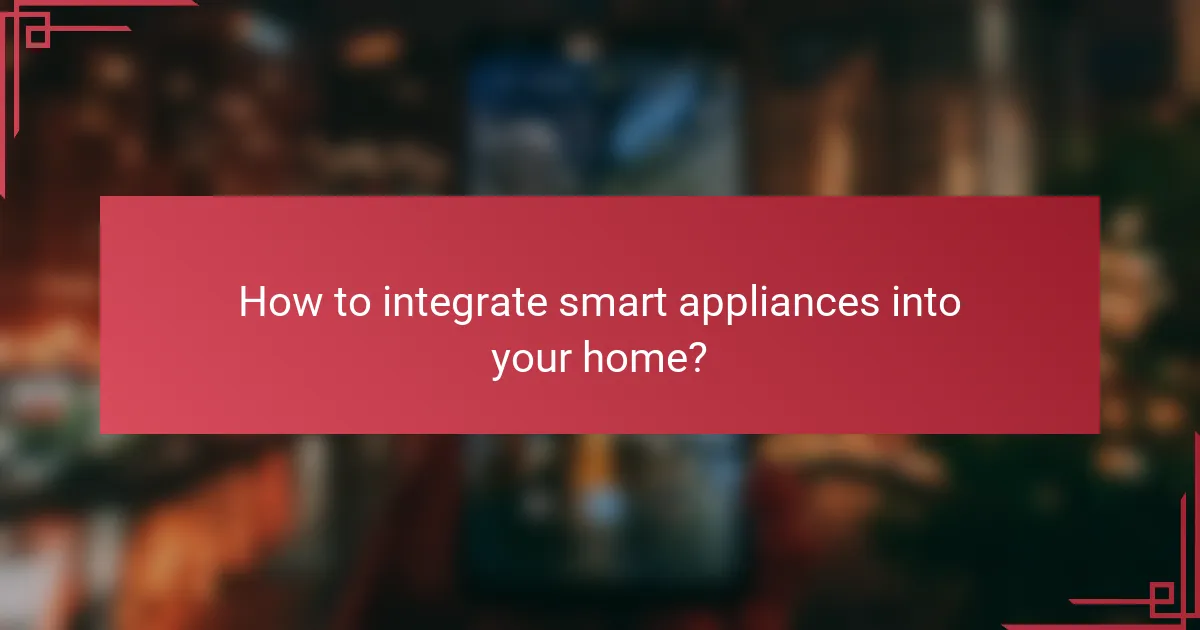
How to integrate smart appliances into your home?
Integrating smart appliances into your home involves connecting them to your Wi-Fi network and ensuring compatibility with existing devices. This process enhances convenience and energy efficiency, allowing for centralized control and automation.
Wi-Fi network setup
To integrate smart appliances, start by setting up a reliable Wi-Fi network. Ensure your router supports the necessary frequency bands, typically 2.4 GHz for most smart devices, as this band offers better range. Place the router in a central location to minimize dead zones.
Consider using a mesh Wi-Fi system if your home is large or has multiple floors. This can help maintain a strong signal throughout your space, ensuring all devices remain connected without interruptions.
Using a smart hub like SmartThings
A smart hub, such as SmartThings, acts as a central controller for all your smart appliances. It simplifies integration by allowing devices from different brands to communicate seamlessly. This hub can manage routines, schedules, and automation tasks, enhancing overall functionality.
When choosing a smart hub, check for compatibility with your appliances. Many hubs support a wide range of devices, but verifying this can save you time and frustration during setup.
Compatibility checks with existing devices
Before purchasing new smart appliances, check their compatibility with your existing devices. Look for products that support common standards like Zigbee or Z-Wave, which facilitate communication between devices. This ensures that your new appliances will work well with your current setup.
Additionally, consult the manufacturer’s specifications or user reviews to confirm compatibility. This step can prevent costly mistakes and ensure a smooth integration process.
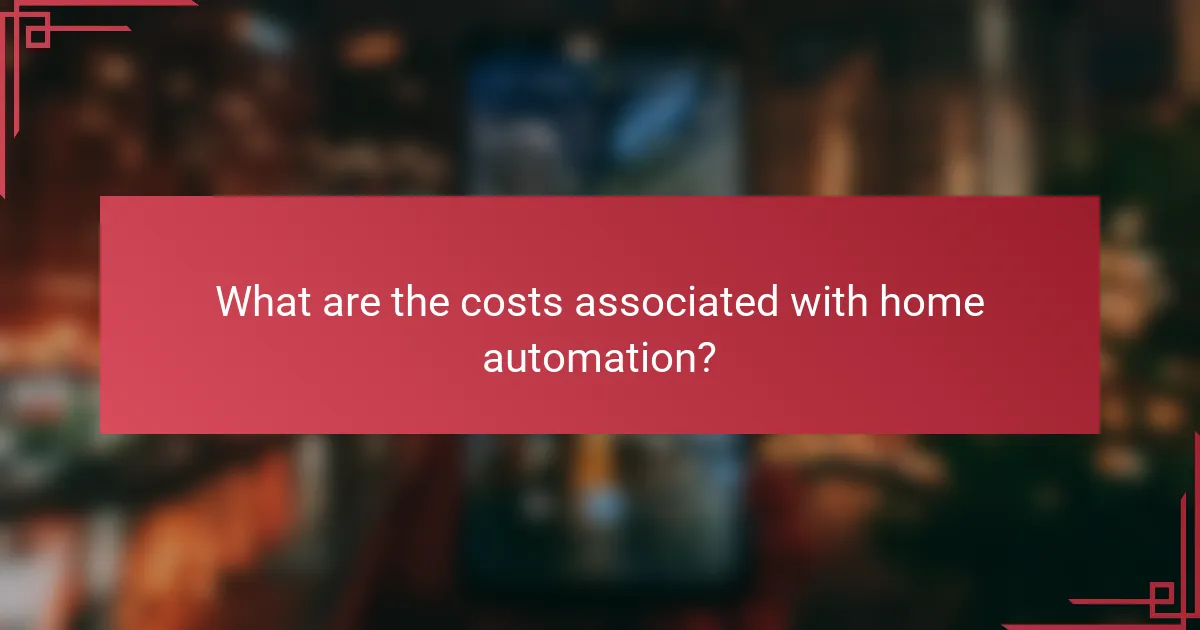
What are the costs associated with home automation?
The costs associated with home automation can vary widely based on the types of smart appliances chosen, installation expenses, and potential long-term savings on energy bills. Understanding these costs helps homeowners make informed decisions about integrating smart technology into their homes.
Initial investment for smart appliances
The initial investment for smart appliances typically ranges from a few hundred to several thousand dollars, depending on the brand and functionality. Basic smart devices like thermostats or light bulbs may cost under $100, while advanced appliances such as smart refrigerators or washing machines can exceed $2,000.
When budgeting, consider not only the purchase price but also the features that enhance efficiency and convenience. Investing in higher-quality devices may yield better performance and longevity.
Installation costs
Installation costs for home automation systems can vary based on the complexity of the setup. Simple devices, like smart plugs or bulbs, often require no professional installation, while more complex systems, such as integrated home networks or security systems, may cost several hundred dollars for professional installation.
Homeowners should factor in potential additional costs for wiring, network upgrades, or compatibility adjustments. Obtaining quotes from multiple installers can help identify the best value.
Long-term savings on energy bills
Long-term savings on energy bills are one of the main benefits of home automation. Smart appliances can optimize energy use, potentially reducing energy costs by 10-30% over time. For example, smart thermostats learn user habits and adjust heating and cooling accordingly, leading to significant savings.
To maximize savings, homeowners should look for ENERGY STAR-rated appliances and consider using energy monitoring systems to track usage patterns. Regularly reviewing energy bills can help identify further opportunities for savings.
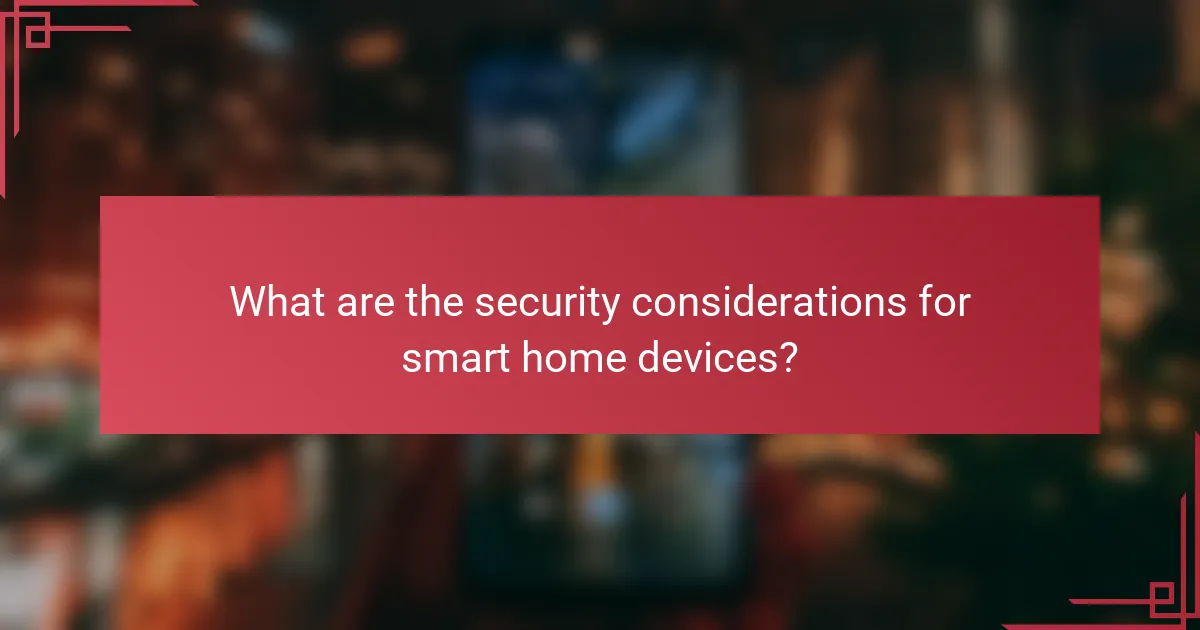
What are the security considerations for smart home devices?
Security considerations for smart home devices include protecting user data, ensuring network integrity, and keeping device software updated. Addressing these areas is crucial to prevent unauthorized access and potential breaches.
Data privacy risks
Smart home devices often collect personal data, which can lead to privacy risks if not properly managed. Information such as usage patterns, location data, and even audio recordings can be vulnerable to hacking or misuse. Users should be aware of what data is collected and how it is stored.
To mitigate data privacy risks, choose devices from reputable manufacturers that prioritize user privacy and comply with regulations like GDPR or CCPA. Regularly reviewing privacy settings and opting out of unnecessary data sharing can further enhance security.
Network security measures
Securing the home network is essential for protecting smart devices. A strong Wi-Fi password, network segmentation, and the use of a virtual private network (VPN) can help safeguard against unauthorized access. Avoid using default passwords, as they are often easily guessed.
Consider enabling network firewalls and regularly monitoring connected devices for any unusual activity. Using a dedicated router for smart devices can also isolate them from other critical devices like computers and smartphones.
Device firmware updates
Keeping device firmware updated is vital for maintaining security. Manufacturers frequently release updates to patch vulnerabilities and enhance functionality. Users should enable automatic updates when possible or regularly check for updates manually.
Establish a routine for checking firmware updates, ideally monthly, to ensure devices are protected against the latest threats. Ignoring updates can leave devices exposed to known vulnerabilities, making them easy targets for cyberattacks.

How do smart appliances enhance lifestyle convenience?
Smart appliances significantly enhance lifestyle convenience by automating daily tasks and providing remote control capabilities. These devices can be programmed or controlled via smartphones, allowing users to manage their home efficiently and effortlessly.
Automation of Daily Tasks
Smart appliances automate routine chores, such as washing clothes or cooking meals, which saves time and effort. For example, a smart oven can preheat itself and adjust cooking times based on the recipe, while a smart washer can schedule cycles based on energy rates, optimizing both convenience and efficiency.
Remote Monitoring and Control
With smart appliances, users can monitor and control their devices from anywhere using mobile apps. This means you can start your dishwasher while at work or check the status of your refrigerator while shopping. Such remote capabilities enhance peace of mind and flexibility in managing household tasks.
Energy Efficiency and Cost Savings
Smart appliances often come with energy-saving features that help reduce utility bills. For instance, smart thermostats can learn your schedule and adjust heating or cooling accordingly, potentially lowering energy consumption by 10-20%. Additionally, many smart devices provide usage statistics, helping homeowners make informed decisions about their energy use.
Integration with Smart Home Systems
Smart appliances can seamlessly integrate with other smart home devices, creating a cohesive ecosystem. For example, a smart refrigerator can communicate with a smart speaker to provide recipe suggestions based on available ingredients. This integration enhances overall functionality and convenience, making daily life smoother.
